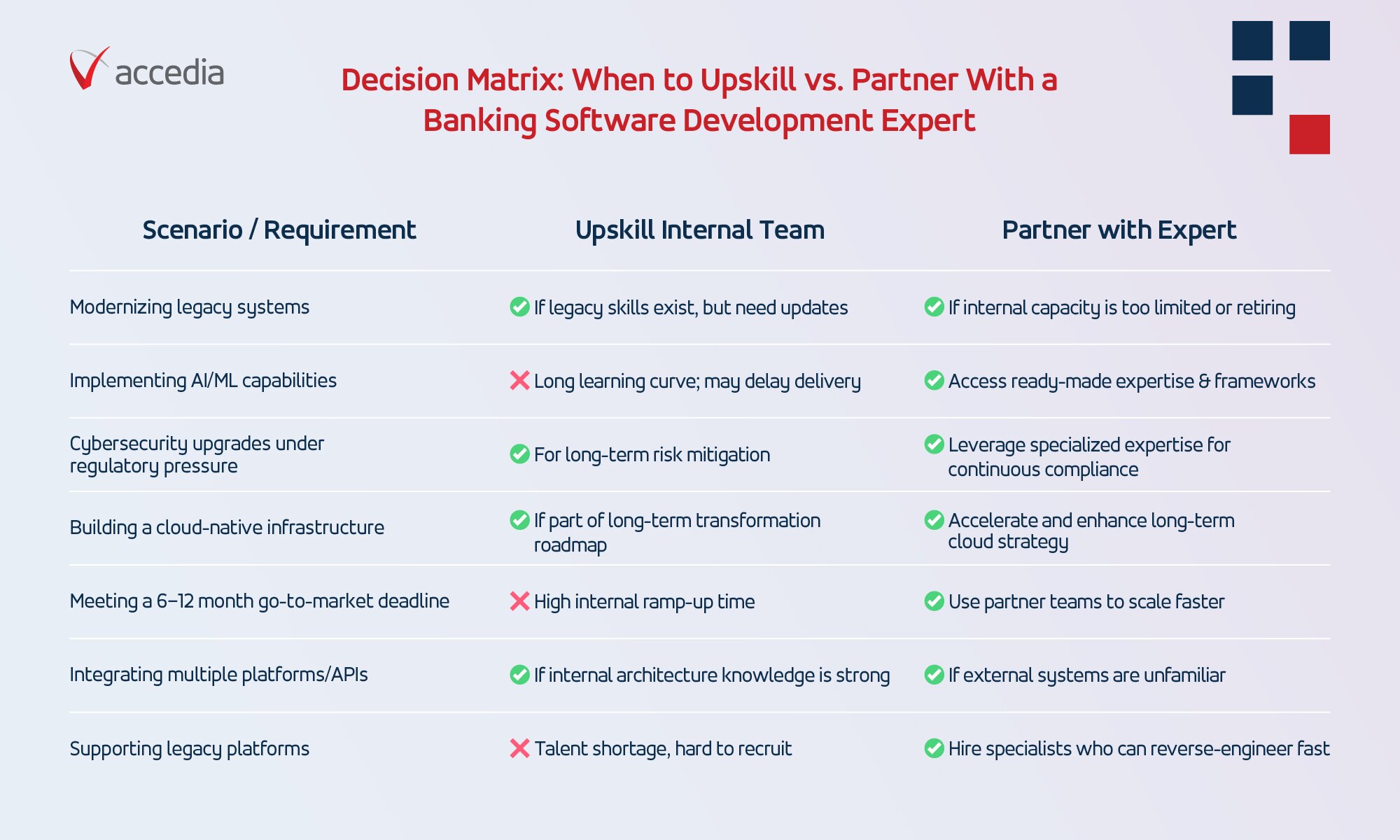Solving the IT Talent Crisis in Retail Banking Software Development
Blog Post
19.05.2025
81% of banking CEOs cite tech talent shortages and cybersecurity as key growth challenges.
Retail banks are investing heavily in digital transformation — from AI-driven services to scalable cloud infrastructure. But while budgets grow and roadmaps evolve, many technology leaders are hitting a wall: a lack of skilled professionals to deliver these plans. As an IT Director, you’re balancing innovation with stability, navigating regulatory demands, and meeting rising performance expectations. And you know that talent shortages in banking software development don’t just slow your progress. They threaten the success of your entire transformation strategy.
Learn How Accedia Can Help You Build Custom Retail Banking Software Solutions
Why Traditional Talent Strategies Are Failing
The disconnect between investment and execution in retail banking is becoming harder to ignore. While banks are evolving digitally, their workforce evolution is lagging. The root of the issue lies in the complex duality of modernization: maintaining legacy infrastructure while building new, AI-enabled systems.
Legacy platforms that are still foundational in many banks require niche expertise. However, many experienced professionals who are fluent in mainframe systems and traditional programming languages are retiring. This leaves a widening skills gap with few successors ready to take over. US banks, for example, often must pay a premium to attract and retain some of the best software engineering talent. Nevertheless, some problems persist. As the senior managing director at a US super-regional bank put it:
“There’s always a deficit in terms of architectural and system architects and software architects where they truly understand the history of why our architecture looks the way it is and how it’s evolved, and understand why. So I think that’s always a key man risk, if you want to call it that.” (Deloitte)
At the same time, the adoption of emerging technologies creates an urgent need for professionals skilled in AI, machine learning, cloud engineering, and cybersecurity. However, these roles are increasingly difficult to fill, especially for smaller financial companies that can’t always compete with the compensation packages offered by tech giants or major banks.
The challenge now is how to move forward — securely, efficiently, and without the full bench of talent traditionally required.
Case Study: How a Leading UK Bank Leveraged AI Agents for Fraud Detection?
Rethinking Talent Strategy Beyond Hiring

When the immediate response is to “hire more engineers,” it’s easy to miss the broader strategic opportunity. The most forward-looking IT leaders are shifting their focus - from expanding headcount to rethinking how banking software development capabilities are built, scaled, and sustained.
In finance, where delays and inefficiencies are often caused by siloed practices and outdated engineering models, embracing agile methodologies is non-negotiable. According to Deloitte, many banks still operate with suboptimal software engineering practices, resulting in bottlenecks across the development life cycle. The future will belong to institutions that pair lean, agile software practices with smarter approaches to talent sourcing and skill set development.
That means you need to focus on building blended teams that combine in-house knowledge with external expertise. It also means recognizing that modernization isn’t a hiring problem, but it’s a capability one. And solving it requires strategic decisions about what to develop internally, what to outsource, and how to continuously grow skills that will support tomorrow’s banking IT solutions.
The #1 Alternative to H-1B Hiring: Build Your Tech Team Without Visa Delays
Strategic Solutions to Bridge the IT Talent Gap
Upskilling and Internal Growth
The fastest way to address today’s talent crisis is to start with the people you already have. Forward-thinking banks are investing in internal upskilling programs focused on high-impact areas like cloud migration, cybersecurity, and AI engineering. With the right training and support, existing IT staff can evolve from legacy roles into critical transformation enablers.
Encouraging cross-functional collaboration between IT, compliance, and product teams also builds organizational resilience. By moving away from narrowly defined roles, banks can create knowledge-sharing cultures that drive innovation across functions.
Of course, not every institution has the scale or structure to build internal academies or run advanced training tracks. And it’s not always necessary. In many cases, supplementing internal growth with the right external expertise is the most effective path forward.
At Accedia, we’ve seen for ourselves how sustained talent development can unlock stronger outcomes for both our teams and our clients. As Engineering Director Peter Ivanov shared in a recent interview, our AI Capability Center and Innovation Development Center give our engineers space to experiment, learn, and apply ideas quickly, which in turn helps our clients benefit from faster, more future-ready solutions. Whether you're building skills internally or partnering externally, creating space for continuous learning is what enables long-term resilience.
Building Agile, Cross-Functional Teams
Modern software development in banking thrives on speed, iteration, and continuous improvement — values at the core of agile methodology. Instead of maintaining siloed departments, leading banks are creating multidisciplinary teams that include developers, testers, DevOps engineers, and business analysts, all aligned around shared goals.
This cross-functional model enhances agility, reduces handoff delays, and promotes a deeper understanding of regulatory requirements and business logic. It’s particularly effective when working on customer-facing platforms where feedback loops need to be fast and flexible. By enabling small, empowered teams to release updates quickly and safely, you’ll be able to meet business demands without overextending internal resources.
Case Study: AI Boosts Customer Engagement by 30% for One of Europe's Top Banks
Scaling Fast with Strategic Partners
It’s smart to recognize that internal capacity has limits, especially when the stakes are high. Strategic partnerships with specialized technology firms can offer you the depth, scale, and speed needed to tackle complex modernization initiatives.

Banking software development companies can bring to your team the technical expertise required for projects like legacy system modernization or AI adoption, while also providing a deep understanding of banking-specific compliance and architectural demands. This ensures a smoother, faster ramp-up and reduces the risk of misalignment or technical debt. Beyond just augmenting capacity, external partners can serve as talent capability accelerators — sharing tools, frameworks, and knowledge that your team can retain long after the engagement ends.
Customer Analytics in Finance: AI and the Future of Hyper-personalization
How Retail Banks Can Act Now
For many retail banks, the IT talent crisis feels paralyzing. But with a clear roadmap, it becomes manageable.
Start by auditing your current technical capacity — not just by role, but by skill set. What critical skills are you missing today, and which ones will be needed to meet your future-state architecture? Align these insights with your digital goals. Then, distinguish which technical areas require in-house development and which can be supplemented through partnerships.
As you build this strategy, shift the hiring mindset from specialization to adaptability. Focus on recruiting professionals who can learn, grow, and operate in agile environments. And finally, create long-term partnerships that provide reliable access to hard-to-hire capabilities like legacy modernization or AI engineering, so you can scale with confidence.
Imagine the difference: backlogs shrink, rollouts accelerate, and knowledge transfer becomes seamless. With the right blend of internal growth and external expertise, your teams become more than reactive problem-solvers. They become proactive enablers of continuous transformation.
Conclusion
Solving the IT talent crisis in retail banking isn’t just a hiring issue. It’s a leadership opportunity. The banks that move fastest won’t necessarily have the biggest budgets, but they will have the most adaptable, resilient teams. Because at the end of the day, software transformation is powered by people. When you invest in talent development, agile ways of working, and trusted technology partners, your initiatives succeed more sustainably.
At Accedia, we help financial institutions close skill gaps, modernize securely, and unlock long-term value. What you build matters, but who you build it with matters even more.
Want to see how this works in practice?
Explore how Accedia helps retail banks modernize securely, from legacy tech to AI, with strategic engineering partnerships.